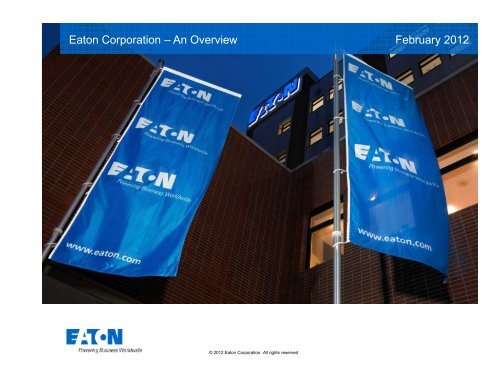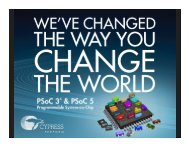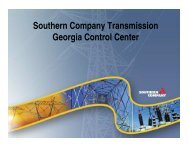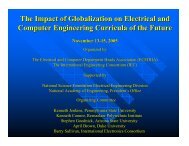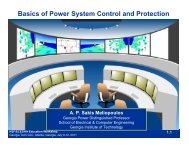Peter Theisen, Principle Engineer, Power Systems and ... - ecedha
Peter Theisen, Principle Engineer, Power Systems and ... - ecedha
Peter Theisen, Principle Engineer, Power Systems and ... - ecedha
You also want an ePaper? Increase the reach of your titles
YUMPU automatically turns print PDFs into web optimized ePapers that Google loves.
Eaton Corporation – An Overview February 2012<br />
© 2012 Eaton Corporation. All rights reserved.
<strong>Power</strong>ing businesses worldwide<br />
for 100 years<br />
• Founded in 1911 by J.O. Eaton<br />
• World Headquarters in Clevel<strong>and</strong>, Ohio USA<br />
• Regional Headquarters in Shanghai, China; Morges, Switzerl<strong>and</strong>;<br />
Sao Paulo, Brazil<br />
• Innovation Centers in the USA, Czech Republic, China <strong>and</strong> India<br />
• Customers in more than 150 countries<br />
• 2011 sales of $16 billion, 55% of sales outside the U.S.<br />
• Approx. 73,000 employees<br />
• Chairman & CEO – Alex<strong>and</strong>er M. Cutler<br />
© 2012 Eaton Corporation. All rights reserved.<br />
2
2011 Financial Highlights<br />
Business Unit Sales Sales<br />
23%<br />
19%<br />
19%<br />
9%<br />
31%<br />
11%<br />
16%<br />
18%<br />
10%<br />
45%<br />
2000 2011<br />
Electrical Aerospace Hydraulics Truck Automotive<br />
© 2012 Eaton Corporation. All rights reserved.<br />
Net income<br />
Operating Earnings<br />
per share (EPS)<br />
Revenue<br />
$16 Billion<br />
$1.35 Billion<br />
$3.96<br />
Electrical $7.2B<br />
Aerospace $1.7B<br />
Hydraulics $2.8B<br />
Truck $2.6B<br />
Automotive $1.7B<br />
3
Eaton Corporation<br />
Innovation in <strong>Power</strong> Management<br />
Pete <strong>Theisen</strong><br />
<strong>Principle</strong> <strong>Engineer</strong> – <strong>Power</strong><br />
<strong>Systems</strong> <strong>and</strong> Architectures<br />
March 2012<br />
© 2012 Eaton Corporation. All rights reserved.
Goals <strong>and</strong> Agenda<br />
Utility/Facility power distribution systems focus<br />
• Microgrids, Net Zero, <strong>and</strong> Renewable/Storage<br />
<strong>Systems</strong> all share common control needs,<br />
protection requirements <strong>and</strong> unsolved problems<br />
• Modern Controls will not have the luxury of<br />
controlling new equipment; must integrate Legacy<br />
Hardware <strong>and</strong> provide dynamic Protection<br />
© 2012 Eaton Corporation. All rights reserved.<br />
5
Smart Grid Implementation Strategies<br />
“Supergrid” <strong>and</strong> “Microgrids”<br />
SUPERGRID<br />
Microgrids<br />
• “Supergrid” -- Top Down Grid<br />
Modernization<br />
• Strengthen Transmission�Automate<br />
Distribution�Overlay intelligence<br />
• Assumed method of Smart Grid implementation<br />
• Driven by Utilities<br />
• Microgrid -- Bottom Up Grid Innovation<br />
• Integrate <strong>and</strong> automate small portions of the<br />
grid<br />
• Reduce grid congestion by optimizing<br />
generation-distribution-loads locally<br />
• Can be owned by either the Utility or privately<br />
Microgrids will be driven by End User (owner) benefits,<br />
Microgrids will be driven by End User (owner) benefits,<br />
not by Utility T&D infrastructure requirements<br />
© 2012 Eaton Corporation. All rights reserved.<br />
6
Microgrids<br />
An isl<strong>and</strong>able dynamic power distribution system capable of<br />
optimizing multiple power generation assets <strong>and</strong> loads through<br />
advanced controls <strong>and</strong> communication.<br />
• Two modes of operation: Grid-tied <strong>and</strong> Isl<strong>and</strong>ed<br />
• Advanced control systems ensure system stability <strong>and</strong> perform<br />
economic optimization<br />
• Distributed control for graceful degradation<br />
• Droop control <strong>and</strong> other techniques accommodate reduced<br />
“inertia”<br />
• Dynamic <strong>and</strong> reconfigurable distribution enhances reliability <strong>and</strong><br />
energy security<br />
© 2012 Eaton Corporation. All rights reserved.<br />
7
Microgrid – Owner Benefits & Typical<br />
Configuration<br />
Reliability / Energy Surety<br />
Continuous electrical supply with or<br />
without availability of Utility grid due to<br />
natural disaster or terrorist attack.<br />
Efficiency<br />
Optimization of local generation options<br />
<strong>and</strong> dem<strong>and</strong> (loads) to reduce<br />
consumption <strong>and</strong> energy costs<br />
Sustainability<br />
Balancing <strong>and</strong> optimizing Utility grid to<br />
reduce need for new, central generation<br />
<strong>and</strong> to alleviate transmission congestion<br />
© 2012 Eaton Corporation. All rights reserved.<br />
Typical Military Microgrid Configuration<br />
8
MicroGrid Requirements<br />
Fundamental:<br />
• Capable of operating at isl<strong>and</strong>ing <strong>and</strong>/or on-grid modes stably<br />
• Mode switching with minimum load disruption <strong>and</strong> shedding during transitions<br />
• After a transition, stabilize in a certain amount of time (how fast?)<br />
Today’s goals:<br />
• Decentralized peer-to-peer: no<br />
master controller or communication<br />
• Plug-<strong>and</strong>-play concept for each<br />
component<br />
• Transitions between modes<br />
• Protection in the MG that does not<br />
depend on high fault current<br />
• Voltage <strong>and</strong> frequency stability in<br />
isl<strong>and</strong>ing mode<br />
Tomorrow’s needs:<br />
• Layered control architecture: device –<br />
MG – grid, defined functions<br />
• St<strong>and</strong>ardize: modularized with high<br />
flexibility for legacy hardware<br />
• Device: local control <strong>and</strong> protection<br />
• MG: info. exchange with device <strong>and</strong> grid,<br />
situation awareness, adaptive protection<br />
• Limited dependence on MG control <strong>and</strong><br />
communication<br />
• Optimal power flow <strong>and</strong> energy utilization<br />
© 2012 Eaton Corporation. All rights reserved.<br />
9
MG Protection Challenges<br />
Operating conditions are constantly changing:<br />
• Intermittent DERs<br />
• Network topology change including isl<strong>and</strong>ing<br />
• Short-circuit currents vary (both amplitude <strong>and</strong> direction) depending<br />
on MG operating conditions<br />
• Availability of a sufficient short-circuit current level in the isl<strong>and</strong>ed<br />
operating mode of MG.<br />
A generic over current protection with fixed settings is inadequate. It<br />
does not guarantee fault sensitivity or selective operation<br />
for all possible faults!<br />
© 2012 Eaton Corporation. All rights reserved.<br />
10
Present MG Protection Philosophy<br />
• Same protection strategies for both isl<strong>and</strong>ed <strong>and</strong> gridconnected<br />
operation.<br />
• The main MG separation switch is designed to open for all<br />
faults.<br />
• With the separation switch open, faults within the MG need to be<br />
cleared with techniques that do not rely on high fault currents.<br />
• Microsources should have embedded protection functions<br />
<strong>and</strong> plug <strong>and</strong>- play functionality.<br />
• Peer-to-peer architecture without dependence on master<br />
device.<br />
© 2012 Eaton Corporation. All rights reserved.<br />
11
MG Protection R&D Needs<br />
Communication-Assisted <strong>and</strong> Adaptive Protection<br />
• How to turn existing radial time-current-coordinated schemes into<br />
fast, selective, <strong>and</strong> sensitive, transmission system – like protection?<br />
• Incorporate existing protection devices (reclosers, sectionalizers,<br />
fuses)<br />
• Minimize additional transducers (CTs, VTs)<br />
• What is the depth of protection awareness?<br />
• Complete MG state (topology, grid or isl<strong>and</strong> mode, type <strong>and</strong><br />
amount of connected DERs)<br />
• Local <strong>and</strong> adjacent protection zones<br />
• Local protection zone only<br />
• How to achieve reliable, fast, <strong>and</strong> cheap communications?<br />
• B<strong>and</strong>width vs cost vs reliability<br />
• What are the most appropriate backup protection schemes?<br />
• What central (MG-level) protection functions are needed if any?<br />
© 2012 Eaton Corporation. All rights reserved.<br />
12
ECE Talent Needs over the next 5+ years<br />
• Electrical <strong>Power</strong> <strong>Systems</strong><br />
• Micro-girds (concrete solutions with legacy equipment)<br />
• Grid-tied systems<br />
• Hybrid systems, storage management<br />
• <strong>Power</strong> Electronics<br />
• Design, control <strong>and</strong> optimization of high performance devices<br />
• Inverters, transformers, motor drives, switches<br />
• Increasing emphasis on DC<br />
• Embedded Control<br />
• <strong>Systems</strong> & supervisory control for complex systems<br />
• Simulation & modeling tool chain<br />
• System diagnostics, prognostics, fault detection <strong>and</strong> safety<br />
• Leadership, entrepreneurial & innovation skills<br />
• Especially PhD, but also BS <strong>and</strong> MS<br />
© 2012 Eaton Corporation. All rights reserved.<br />
13
For more information on innovation technology, contact:<br />
<strong>Peter</strong>J<strong>Theisen</strong>@eaton.com<br />
For more information on student employment opportunities contact:<br />
Kevinebailey@eaton.com<br />
© 2012 Eaton Corporation. All rights reserved.<br />
14


